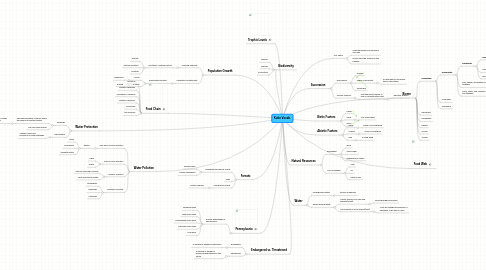
1. Food Chain
1.1. Producer
1.2. Primary Consumer
1.3. Secondary Consumer
1.4. Tertiary Consumer
1.5. Scavenger
1.6. Decomposer
2. Forests
2.1. Temperate Deciduous Forest
2.1.1. Pennsylvania
2.1.2. Mostly Needleless
2.2. Trees
2.3. Coniferuous Forest
2.3.1. Mostly Needles
3. Trophic Levels
4. Biodiversity
4.1. Genetic
4.2. Species
4.3. Ecosystem
5. Endangered vs. Threatened
5.1. Endagered
5.1.1. A species in danger of extinction
5.2. Threatened
5.2.1. A species in danger of becoming endangered in the future
6. Population Growth
6.1. Carrying Capacity
6.1.1. Limited by Limiting Factors
6.1.1.1. Disease
6.1.1.2. Natural Disasters
6.1.1.3. Hunting
6.2. Population Growth Rate
6.2.1. Exponential Growth
6.2.1.1. J curve
6.2.1.1.1. Beginning
6.2.1.2. S curve
6.2.1.2.1. Ending
7. Water Pollution
7.1. Non-point Source Pollution
7.1.1. Runoff
7.1.1.1. Trash
7.1.1.2. Dog Waste
7.1.1.3. Cigarette Butts
7.2. Point Source Pollution
7.2.1. Pipes
7.2.2. Drains
7.3. Organic Pollutant
7.3.1. Natural Cleaning Products
7.3.2. Food Processing Waste
7.4. Inorganic Pollutant
7.4.1. Detergents
7.4.2. Medicines
7.4.3. Fertilizers
8. Water Protection
8.1. Wetlands
8.1.1. Absorbs bad gases in the air and in the ground to protect waters.
8.1.1.1. It also collects trash which comes off of impermible surfaces.
8.1.2. Can also stop erosion
8.2. Urbanization
8.2.1. Causes runoff and pollutants to enter wetlands
9. Pennsylvania
9.1. 5 major watersheds in Pennsylvania
9.1.1. Delaware Basin
9.1.2. Ohio River Basin
9.1.3. Susquhenna River Basin
9.1.4. Potomac River Basin
9.1.5. Erie Basin
10. Hot Spots
10.1. Great abundance of species in one area
10.2. Mostly near the Tropics by the Equator
11. Biome
11.1. Ecosystem
11.1.1. Community
11.1.1.1. Population
11.1.1.1.1. Organism
11.1.1.1.2. School of Fish
11.1.1.1.3. Pack of Dogs
11.1.1.2. Fish, Sharks, and whales live together
11.1.1.3. Lions, Tigers, and Monkeys live together
11.1.2. Coral Reef
11.1.3. Grasslands
11.2. Rainforest
11.3. Freshwater
11.4. Desert
11.5. Marine
11.6. Tundra
12. Food Web
13. Abiotic Factors
13.1. Paper
13.1.1. Peice of a living thing
13.2. Corpse
13.2.1. Once a living thing
13.3. Fish
13.3.1. A living thing
14. Biotic Factors
14.1. Paper
14.2. Sand
14.2.1. Non living thing
14.3. Glass
15. Succession
15.1. Ecoclogical
15.1.1. Primary
15.1.2. Climax Community
15.1.2.1. An ecological community that is very stable
15.1.3. Secondary
15.2. Pioneer Species
15.2.1. First species to appear in new or reconstructed land
15.2.1.1. Indicator species
16. Water
16.1. Underground Water
16.1.1. Strored in aquafirs
16.2. Above ground water
16.2.1. Mostly found in ice caps and glaciers(Fresh)
16.2.1.1. Goes through purification
16.2.2. The majority is in the oceans(Salt)
16.2.2.1. Must go through the process of desilation to be able to drink
17. Natural Resources
17.1. Renewable
17.1.1. Wind
17.1.2. Solar Power
17.1.3. Hydroelectric Power
17.2. Non-renewable
17.2.1. Coal
17.2.2. Oil
17.2.3. Natural Gas
